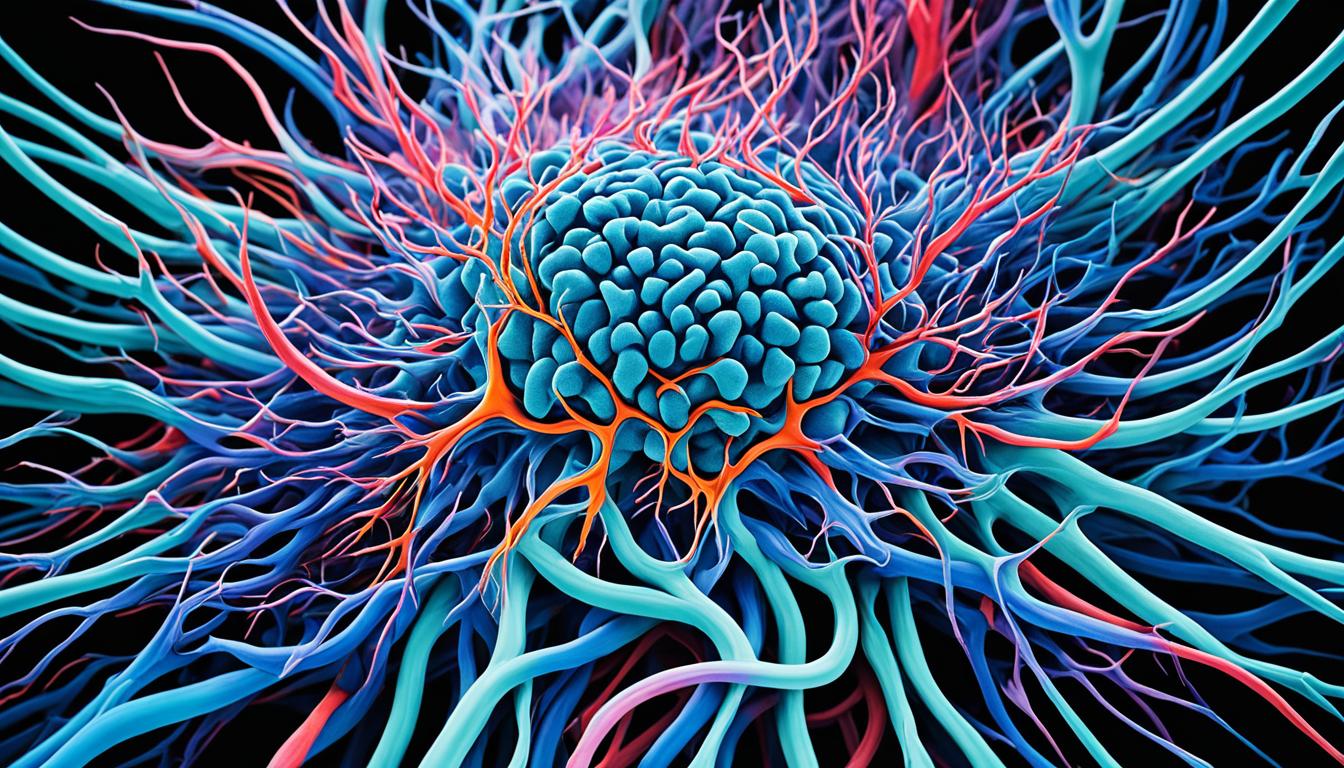Malignant peripheral nerve sheath tumors (MPNSTs) are rare cancers of the nerves’ lining. They typically appear in deep tissues of the arms, legs, and trunk. These tumors, also called neurofibrosarcomas, can happen anywhere in the body.
Symptoms of MPNSTs include pain, weakness, and a growing lump under the skin. The cause is unknown, but it’s linked to DNA changes in nerve cell surroundings. Risk factors include past radiation therapy, certain genetic conditions, and noncancerous nerve tumors like neurofibroma.
The main treatment for MPNSTs is surgery. Some cases may need radiation therapy or chemotherapy. New treatments with stem cells are under investigation for their potential.
Key Takeaways:
- Malignant peripheral nerve sheath tumors (MPNSTs) are rare cancers that originate in the lining of the nerves.
- Common symptoms of MPNSTs include pain, weakness, and the presence of a growing lump under the skin.
- The exact cause of MPNSTs is not yet known, but DNA changes in the cells surrounding the nerves may contribute to their development.
- Treatment options for MPNSTs include surgery, radiation therapy, and chemotherapy.
- Stem cell therapy is being explored as an innovative treatment approach for MPNSTs.
Symptoms and Diagnosis of Malignant Peripheral Nerve Sheath Tumors
Malignant peripheral nerve sheath tumors show various symptoms. It depends on where and how big the tumor is. You might feel pain at the tumor site, have trouble moving that body part, and notice a growing lump.
If these issues are ongoing and concern you, see a doctor. MPNSTs are rare and might look like something else at first.
Doctors use imaging tests and biopsies to diagnose MNPSTs. They might do more tests to see if the disease has spread.
- Pain: You might have persistent pain at the tumor site. It could get worse when moving or touching it.
- Weakness: Moving the affected body part could be hard. This might come with muscle weakness.
- Lump or mass: A lump or mass could grow under your skin. It might be sore and cause skin changes.
- Neurological symptoms: These can vary by tumor location. You might feel tingling, have numbness, or find coordination difficult.
- Progression of symptoms: MNPST symptoms usually get worse over time. Quick medical help is key for a proper diagnosis.
If you have any of these symptoms or worry about MNPST, talk to a doctor. Early treatment can lead to better results for those with these tumors.
Treatment and Prognosis of Malignant Peripheral Nerve Sheath Tumors
Surgery is the key treatment for malignant peripheral nerve sheath tumors. It aims to cut out the tumor and some healthy tissue. By taking this tissue, doctors try to stop the cancer from growing back. Sometimes, before or after surgery, radiation therapy and chemotherapy might also take place.
These extra steps can make the tumor smaller and kill off any leftover cancer cells. This helps lower the chance that the cancer will come back.
The prognosis for MPNSTs can change based on many things. This includes the tumor’s size, where it is, how far it has grown, and the patient’s general health. Usually, MPNSTs are harder to treat than other soft tissue sarcomas.
But, doctors are finding new ways to improve the prognosis. They are studying stem cell therapy and how targeted therapies and immunotherapies can help. These new treatments are bringing hope for a better future for MPNSTs patients.
For someone with an MPNST, working with a healthcare team is very important. Together, they can make a treatment plan that fits the patient. Also, keeping up with check-ups is crucial. It helps catch any return of the cancer early on.
Being active and well-informed is key for a good result and a better life quality for these patients.

